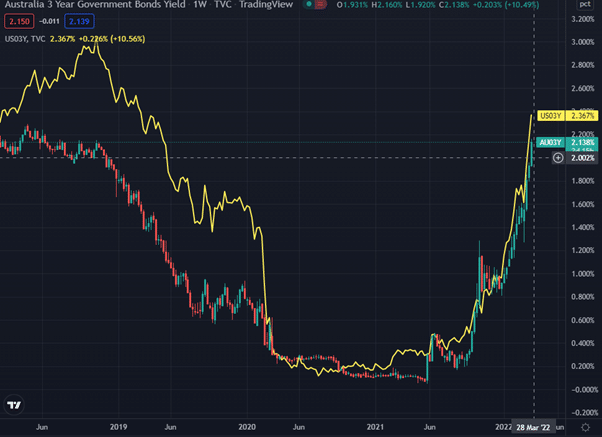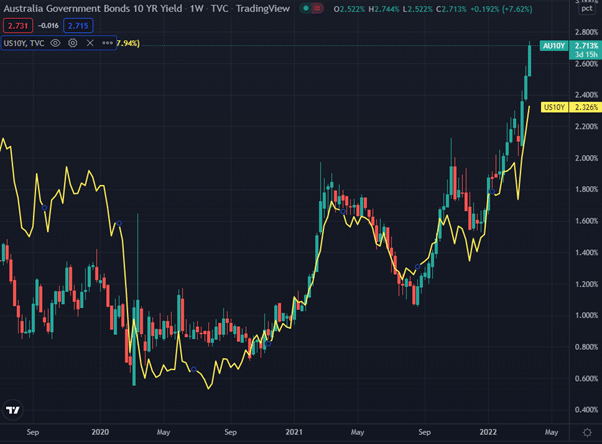- Accounts
- About
- Trading
- Platforms
- Tools
- News & education
- News & education
- News & analysis
- Education hub
- Economic calendar
News & Analysis
An update on Jerome Powell’s (Federal Reserve) latest speech
23 March 2022The US Federal Reserve (Fed) has recently doubled down on their hawkish views, after Jerome Powell’s latest speech. There are preparations to substantially increase the interest rate in May. The speech has subsequently put pressure on the Australian Reserve Bank (RBA) to raise the interest rate at a faster pace.
Mr Powell said “the US central bank could raise rates in 50 basis point increments at upcoming meetings and leave rates higher in the longer term than would have traditionally been expected.”
Earlier last week, the Fed had increased its benchmark rate by 25 basis points to 50%, this is the first time it had been increased in three years. This was intended to help curb the 40 year high in inflation. This decision shows the Fed’s willingness to increase the rates as needed.

The Australian three-year government bond rate has recently cracked the 2% mark, it hasn’t been above this level since 2018. Bond traders have taken interest and increased their bets on the RBA policy tightening. They also expect the overnight cash rate to be at 1.57% by the end of the year, which indicates the rate to be increased up to seven times. It was previously expected to increase five times.
The bond rate is sensitive to short-term interest rate expectations. The US three-year bond yield has also increased, sitting at 2.367%. This indicates that the Fed will increase its benchmark rate more than the RBA.
The big four banks have different forecasts when it comes to the RBA’s decision to increase the rates. Westpac and NAB believe the rate hikes will occur in August. CBA expects it to be earlier in June. ANZ has not announced their intentions as they are waiting for the September RBA meeting to make an informed decision.

The Australian/US dollar exchange rate is currently floating around the 74 cents mark. This currency can be a liquid proxy for global growth or risk appetite in general. It has remained relatively stable since the conflict in Russia and Ukraine.

Australian 10-year bond yield is currently higher compared with US’ yield. This has also provided support for the Australian dollar.
The rising oil prices will also provide further support for the Australian dollar as Australia is a net exporter of energy.
All in all, the recent speech from Mr. Powell has provided tremendous insight into where the Federal Reserve is heading. The RBA can potentially follow their lead and this would result in knock on effects, which would in turn affect the AUD/USD. Many investors are keeping a keen eye on the current interest rate hike timeline.
If you would like to take this opportunity to invest in the AUD/USD and don’t already have a trading account, you can register for a Forex CFD account at GO Markets.
Source: GO Markets, Tradingview, Bloomberg, AFR
Disclaimer: Articles are from GO Markets analysts and contributors and are based on their independent analysis or personal experiences. Views, opinions or trading styles expressed are their own, and should not be taken as either representative of or shared by GO Markets. Advice, if any, is of a ‘general’ nature and not based on your personal objectives, financial situation or needs. Consider how appropriate the advice, if any, is to your objectives, financial situation and needs, before acting on the advice. If the advice relates to acquiring a particular financial product, you should obtain and consider the Product Disclosure Statement (PDS) and Financial Services Guide (FSG) for that product before making any decisions.
Next Article
US stocks continued moving up overnight with the technology sector outperforming
The US technology sector rose again last night and worked back the losses from the previous day of trading as the market came to grips with the Federal Reserve’s announcement surrounding interest. Tesla was a standout performer and has seen a huge rise in the last week rising more than 20% and rising 7.91% overnight. The Nasdaq moved up 1.95%. Th...
March 23, 2022
Read More >
Previous Article
Adobe’s latest numbers are in
Adobe Inc. reported its financial results for fiscal first quarter 2022 after the closing bell on Wall Street on Tuesday. The American software com...
March 23, 2022
Read More >

